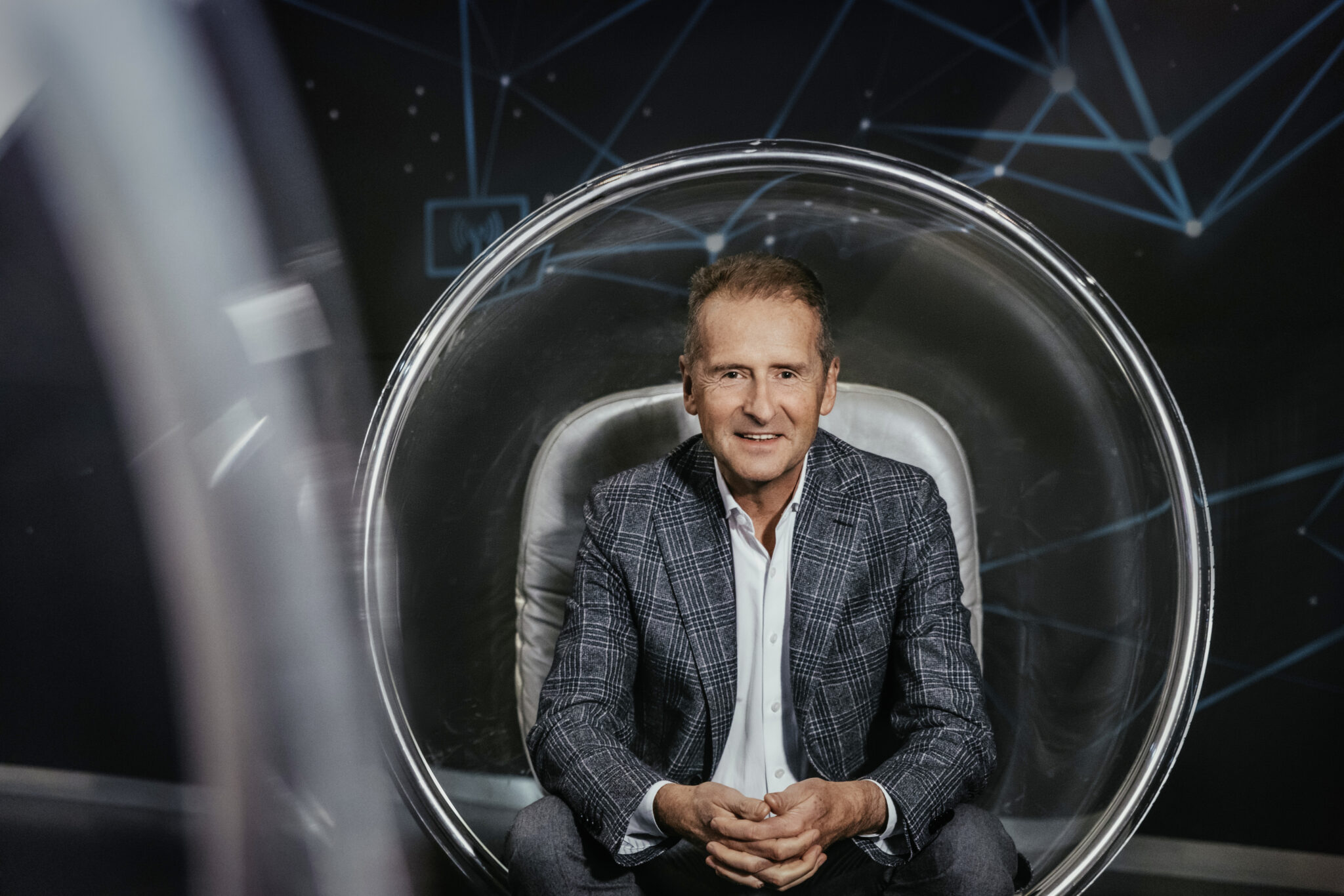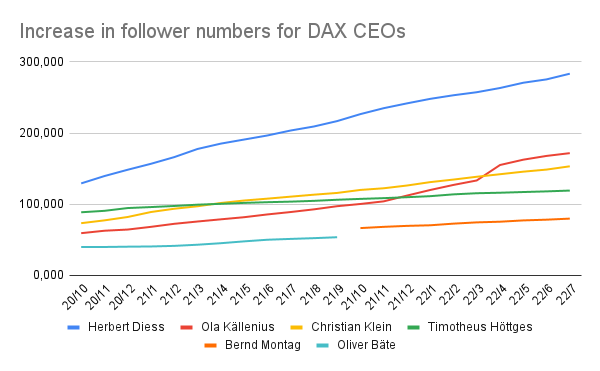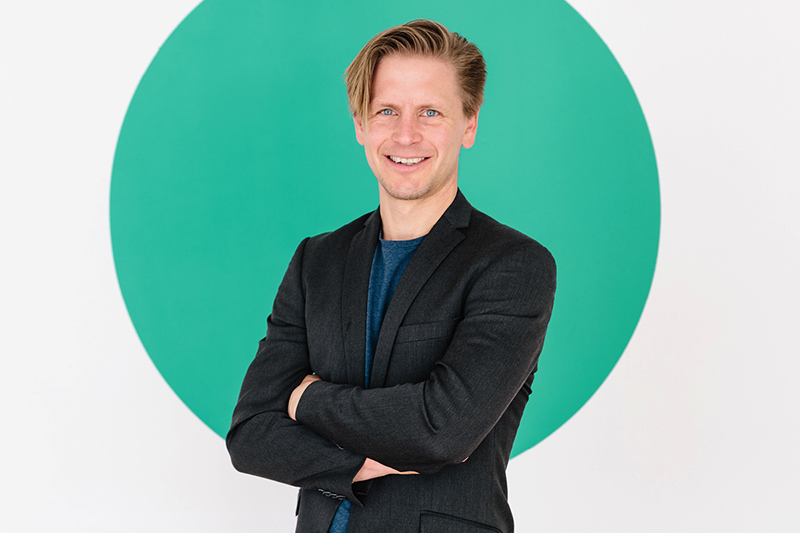
On the departure of Herbert Diess – and what we can learn from him about LinkedIn
Outgoing VW CEO Herbert Diess understood LinkedIn like no other German CEO – and he used that understanding for his own purposes. Below are four key elements that managers can adopt for their LinkedIn communication.
What do Michael J. Fox and Herbert Diess have in common? It is probably the most striking image that the “Back to the Future” star and the outgoing VW CEO leave in the collective memory. In Fox’s case, it’s his cinematic rides on a hoverboard; in Diess’s case, it’s the very similar performance on an electric surfboard on the lake at the VW plant in Wolfsburg.
What distinguishes Michael J. Fox from Herbert Diess? In his quest for media visibility, the US actor once often had to wait months for the next flick to hit movie theatres. Diess, on the other hand, can beam himself into the mass media almost in real time and without a gatekeeper – thanks above all to LinkedIn, where his e-surfboard action video also had its film premiere.
At the end of Diess’s term in office, we take a look back:
1. LinkedIn has a direct business impact
“LinkedIn is not just a communicative medium for me – it has long been a management tool as well,” Diess once said in an episode of the Online Marketing Rockstars podcast. Diess has used the platform primarily to communicate his view of VW’s strategic direction in an unfiltered way (to the extent that this is possible in a large corporate comms structure). To strengthen the focus on e-mobility, which he strongly promotes, he once even indirectly advised against buying a car with an internal combustion engine – and calculated how expensive the corresponding VW models are. Just 30 minutes after his LinkedIn post, the news was the top story at Spiegel Online. No press release is faster.
In the long term, the question arises as to how much executives still need the traditional media: with 12.9 million active users per month in Germany, LinkedIn already has more reach than the Tagesschau (the evening news) (11.8 million). Not to mention a newspaper as “seemingly” large as the Frankfurter Allgemeine Zeitung (960,000).
Less product-related but more lobbyist in nature were Diess’s demands for the 2021 federal election: “We would like the following 10 points to be included in the negotiations,” he explained in a post. Such content does not replace lobbying, but it complements it and anchors the messages in the collective memory. After all, what 12.9 million people can (theoretically) read carries more weight than what’s discussed only in proverbial back rooms.
LinkedIn has a direct business impact. And as a communications agency, we are also seeing this in more and more projects where we help position corporate ambassadors – whether that’s in strategic positioning, as in Diess’s case, or in sales, recruiting or customer dialogue.
2. LinkedIn is the new intranet
Diess has understood that social networks are not just external channels. Companies as well as executives send strong messages internally. On many profiles, 30% to 50% of active users are internal. “In the past, you waited a week for feedback, but today I get immediate – and unfiltered – feedback,” Diess once said. “I can see immediately from questions that come in whether what I said was understood.”
A top manager we support with In A Nutshell confirms this: “Of course, I can also have a statement put on the intranet. But honestly, who reads that there? On LinkedIn, I have five times the reach.”
In terms of reactions, the business network does even better: while many employees are reluctant to like or comment on such official media as the company’s own intranet, they engage in dialogue much more frequently on LinkedIn – often even with very substantial feedback, especially via personal direct messages.
Diess has also acted as a role model internally. We have noticed in various agency projects that when top executives are actively involved in social media, the willingness of employees to also post professional content on LinkedIn, Twitter and Instagram increases significantly. In short, without a “social CEO”, a corporate ambassador culture is difficult to achieve.
However, LinkedIn reaches its limits in internal communication when the topics become critical – Diess is also the best example of this. A few hours before his departure became public, he said goodbye via a LinkedIn post. Not from his office, however, but while on vacation – without a word about the resignation.
3. LinkedIn strengthens employee retention
Business networks such as LinkedIn and Xing have long been known as recruiting tools. Those who use corporate ambassadors to tell personal stories about the company and at the same time post ads for suitable jobs have a much easier time in the war for talent than the competition. Employee retention can also be supported via LinkedIn.
That’s why Diess, who regularly contributed personally to discussions under his posts, also devotes most of his time on LinkedIn to “his” people. The best example was this post: Eric Wurzel, an employee from VW logistics, received a response – while star investor Frank Thelen did not.
On the other hand, LinkedIn strengthens the sense of community: we provided communications support for a very successful internal charity campaign for a finance client. The client company had made an internal appeal for employees to go jogging for a good cause during the pandemic – with a donation of one euro per kilometre. Right from the start, the challenge was accompanied by selfies and mini-videos of the colleagues on LinkedIn. Some of the top managers took part in the run themselves and were also busy handing out praise and likes. The final survey showed that this form of digital community-building had massively increased participation and the fun factor. To put it in social media parlance: #TheStarIsTheTeam.
4. LinkedIn is do-it-yourself
One of the reasons Diess has been so successful – and will soon become the first German top manager to achieve 300,000 followers – is that he got himself involved right from the start. As part of our ongoing social CEO monitoring, we have tracked the follower numbers of the DAX leaders, and the numbers show how much Diess has outpaced his peer group:

First, this was because he was very active: in some months, Diess posted every other day – according to the figures from our social CEO monitoring, this was 50% more than the average. Among Diess’s DAX peers, only Ola Källenius of Mercedes-Benz was more active. Diess also used Twitter, by the way, but more as a “feeder” for his LinkedIn posts.
Second, Diess himself was very involved, sitting with his communications team for up to two hours every Monday, planning new stories, taking selfies, and fielding questions and criticism in the comments.
The engagement rate (share of users who like, share or comment, in relation to the total number of followers) was correspondingly high for Diess’s posts. In 2021, before his departure from VW became definite, the engagement rate – the most important KPI – was over 20% in some months.
By way of comparison, corporate websites of DAX companies averaged an engagement rate of 1.4% for the same period. People want to talk to people. Diess has understood that, too.
A new CEO – now what?
The question remains: what happens next? The last major LinkedIn CEO in Germany before Diess, Dieter Zetsche, withdrew completely after stepping down. He still has over 248,000 followers – but only 4 contacts. It’s almost as if someone had consistently deleted most of them. Zetsche hasn’t posted since, either. Michael Zahn, former CEO of Deutsche Wohnen, did the same.
In strictly legal terms, the LinkedIn profile belongs to the person in question, and that person takes it with him or her when the employment contract ends. Losing well-connected employees is therefore a bitter pill, because they represent real business capital. It is even more painful at the executive level, when a lot of energy and working time has been invested in building up such a profile over the years.
VW now has a lot of work to do in terms of CEO positioning: unlike almost 80% of the DAX 40 CEOs, Diess’s successor, Oliver Blume, does not yet have a social media profile.

Timm Rotter
FOUNDER & MANAGING DIRECTOR
Would you like to learn more about Executive Positioning on LinkedIn?
Then send me an email and increase your engagement.
Titelbild: Volkswagen AG
